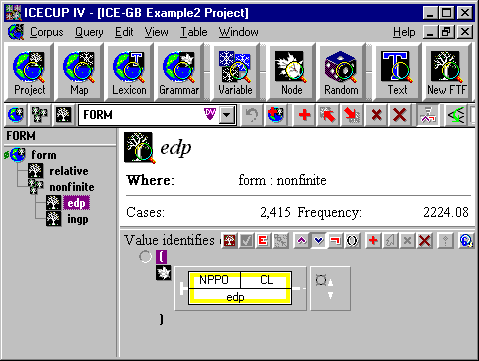Defining experiments
ICECUP IV allows you to define a formal experiment on the corpus. An experiment consists of two or more variables centred around a common definition of a case. A case is the object of our research - a clause, phrase, structure, lexical sequence, wild card, etc.
A case is defined by a Fuzzy Tree Fragment (FTF). An FTF is a grammatical query that matches part of a sentence tree. They can match the same sentence tree more than once.
The aim of an experiment is to try to find and evaluate hypotheses which predict one variable, called the dependent variable (DV), on the basis of the other variables across the set of relevant cases taken from the corpus.
Let’s take a simple example. This is described fully in the downloadable guide Getting Started with ICECUP IV.

The Project window has three parts.
- On the left hand side is the variable structure editor. This allows you to label and arrange the different values of the variable. Variables can be discrete alternatives {a, b, c...} or hierarchical, as shown here.
- At the bottom right is a logical query editor for defining each value of the variable. Values are defined in terms of a mapping rule containing a logical combination of queries. This dependent variable, form, is a grammatical variable containing a different FTF for each of its values.
- At the upper right is a detail panel showing more information about the selected value.
ICECUP supports three types of variable.
- Sentence variables include sociolinguistic queries. They are defined to have one value for any given sentence tree in the corpus.
- Grammatical variables contain FTFs. These variables have a single value for each matching case in the corpus.
- Grammatical count variables also contain FTFs. These count the number of times the FTF pattern matches the case.
Once two variables are defined, we can carry out an experiment to see if the values of one variable (the independent variable) predicts values of the other (the dependent variable).
This page last modified 7 July, 2020 by Survey Web Administrator.